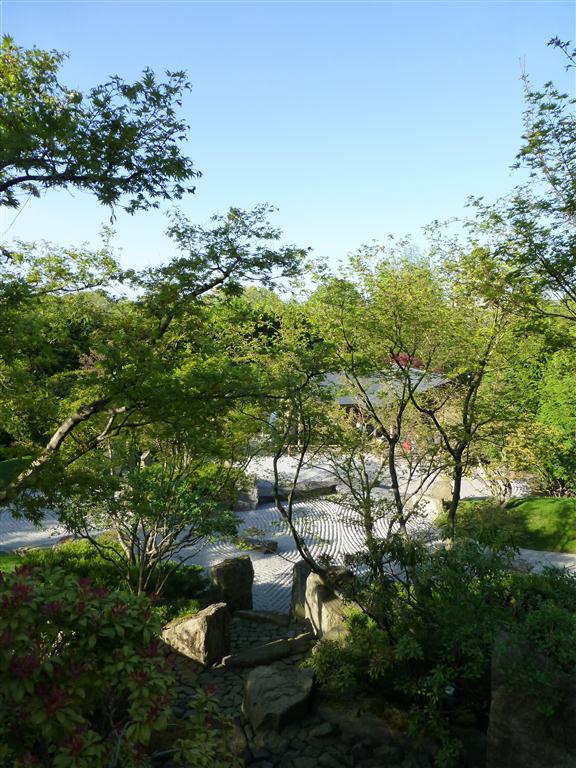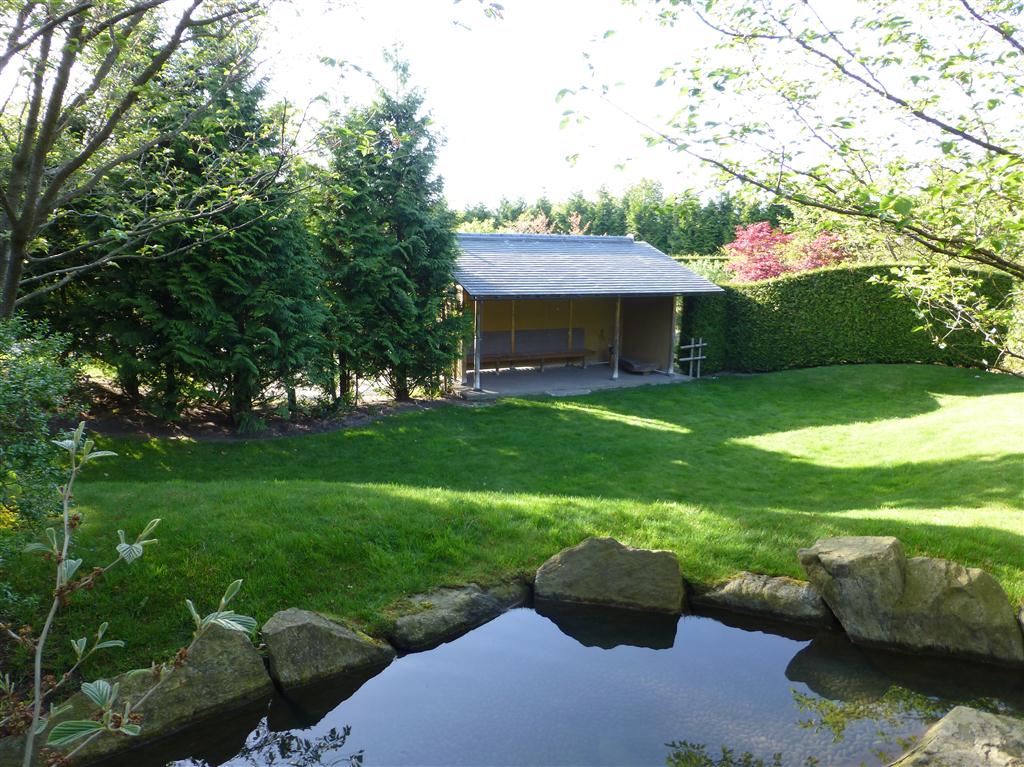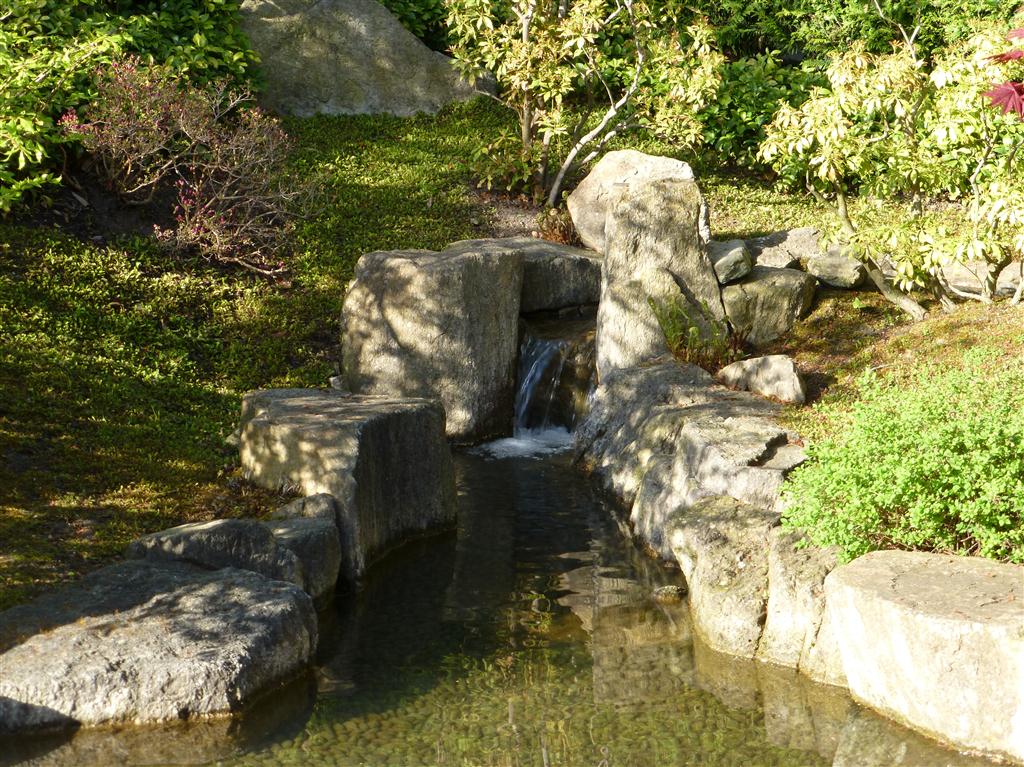Feng Shui Nature
Japanese Gardens
Japanese gardens are famous for its artful realisation of nature. Similar to Chinese gardens the aim is to reproduce the perfect natural landscape. Many Japanese gardens hence use the same or similar techniques that are known of the Chinese garden, where Feng Shui often is an integral part. Within the art of japanese gardens, the following types can be differentiated:
- the Pond Garden
- the Dry-Landscape Garden
- the Tea Garden
- the Enclosed Garden
The Pond-Garden
The japanese pond garden with the central element of water is very similar to Chinese gardens. The first written reference to Japanese garden was made in the 7th century which means we are now able to look back at a history of garden design for over 1.400 years. The actual design of the garden was always dependent on the inhabitants self-view. A garden with larger water-features and islands for example re-presented the inhabitants living and coming from an island. Pond gardens were especially popular amongst the nobles. It underlines their self-view of an island-people.
In Palace gardens and gardens for the noble central features included a ceremonial place, soft outlines of hills, a place to worship the ancestors as well as lakes and suitable wild flowers.
A temple garden would ensure that the main hall and the Buddha situated inside would be able to overlook a calmful lake with lotus-flowers.
To ensure that the garden has both space and depth artificial hills, soft valleys and lively peaks would find their place in the classic design of a japanese garden. Plants are planted with large spaces inbetween.
The lake is the central part of the garden. Especially with artificial lakes the form plays a key symbolic role. The form for example would represent:
- the chinese character for "soul"
- the chinese character for "water"
- the form of a river
- the form of a cubic bottle
- the form of a cloud
Example lake forms:


Left: character for "soul" | right: character for "water"
Similar to the Chinese garden it is very important on how the garden is perceived by its visitor / viewer. Bridges, platforms and the path-ways have hence a special importance.
The Dry-Landscape Garden
The japanese dry-landscape garden is the most famous garden-type from Japan. It is known as Zen-Garden. Water is replaced by sand and pebbles.
We first find notes on this type of garden back in the 14th century when famous Zen-Masters created this form to transport important Zen-Teachings and Buddhist wisdom. Especially the arrangements of the rock has a special meaning.
Before the 17th century temple gardens required a water feature for ritual use. It was only with a change of Tempel rules that this requirement due to scarceness of water was made obsolete. It is from then on that the dry-garden became the dominant one.
Due to scarce water, moss, bushes and pine trees were included in an artificial langscape of hills and rivers in abstract and round forms. Rock formations are used to represent water falls and stilised raked sand and pepples represent water streams. The gardens hence represent Zen Teachings. The abstract forms underline and support the mental excercises and medtation on time, space, change and duration.

In those gardens where access to water exists, an interwoven play between real and artificial water is created. A great example of this can be seen in the Japanese Garden in Berlin-Marzahn where not only real and artificial water contrast each other but all kinds of feng shui mastery find its application - like for example the game between master and servant. (for more details visit: An Introduction to Landscape and Garden Feng Shui).
A Zen-Garden is always a game of contrast and harmony between the dry features and that of plants and their colours.
Elements of a Japanese Garden
Japanese gardens are created full of symbolic meaning. The following elements are used to convey the special meaning and none of the placements and creations are left to chance:
- form of the lake / pond (see above)
- bridges and viewing platforms
- paths and stepping stone and their direction
- sand and pepples and their raked shape and form
- rocks and rock formations
- Plants and their (partly artificially creatd) form (e.g. bonsai-form)
- lanterns (see below)
- bamboo fences and stone walls
- gates
Examples of japanese laterns and their shape:



Pictures left to right: Lanterns with legs can often be found between bushes around the lake, Tachi-Gata were originally used in Shrines and Temples and Okigata is placed on flat stones.
An Introduction to Landscape and Garden Feng Shui
An Introduction to Landscape and Garden Feng Shui
In China garden design means that the space, even though artificially created, is as close to nature as it can possibly be. This stands in great contrast to Western garden designs, like the renaissance garden, where artistic shapes and linear designs are preferred.
You'll find that daoist philosophy finds many expressions within Garden Feng Shui, one of the main themes is to create a holistic image of nature in a small confined space.This is reflected by presenting and combining various elements like mountains, water, buildings, trees, flowers but also air currents, moon reflections and seasons to one element, representing one unit where human beings and nature can co-exist harmoniously.
Many different types of gardens exist in China. You'll find Gardens of the Emperor, private gardens, gardens belonging to temples as well as landscape gardens and holy mountains (e.g. Wudang Shan) where gardens have been incorporated into the natural surroundings already existing.
Even though garden and landscape feng shui can look back on a long history the actual feng shui garden theory was only developed during the Ming Dynasty. One corpus, which qualifies as the fundamental work, has been created by the scholar Ji Cheng (born 1582).
Thus the theory claims:
The garden follows an inherent logic, but has no specific expression, it seems to be constantly changing.
Its design is so natural that is feels like nature. (...)
Although it was created by man, it seems like it has grown naturally.
In contrast to the West, a property in the Asian area is planned with the garden first. The garden is the heart of the premises and a building would only follow after the main garden has been designed.
Thus follows:
A garden is always a room of the house.
A house is always an element of the garden.
Here are some of the main concepts of Garden Feng Shui:
- Tian Jing "Well of the Sky"
- Master and servant
- Interior and exterior orientation
- Routing and direction changes
- Narrow and wide as spatial contrasts
- Emptiness and fullness / regularly and randomly
- Up and down views
- the 5 Elements (also called Five Phases)
An example:
The Japanese Garden at Marzahner Erholungspark in Berlin.
This garden was created by a Japanese Zen Monk applying Feng Shui.Concept: Master and Servant.
The master of a garden is the highlight of the garden:

The servant of a garden is a first glance at the highlight, obscured, not fully, but making you curious - an example here is a distant glance through trees shortly after entering the garden.

If you have a large garden area that several masters can work together: There is more than one highlight in the garden.
"Several masters work together":


This is one of many aspects of the Japanese Garden in Berlin - definitely worth a visit.




